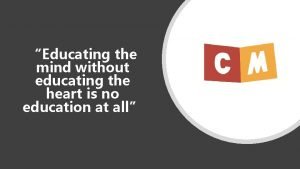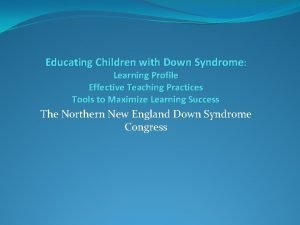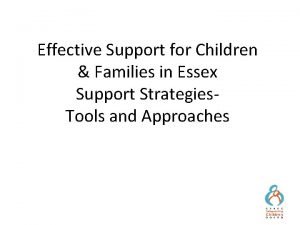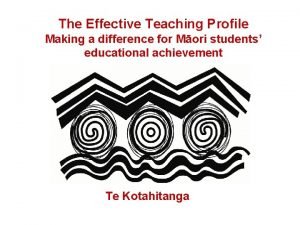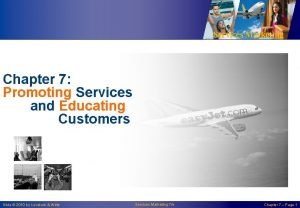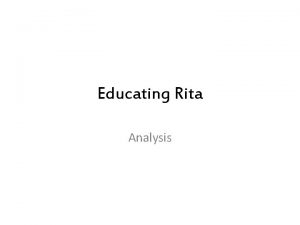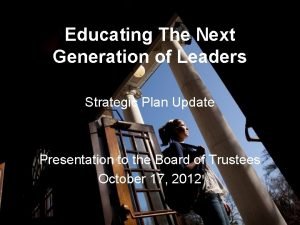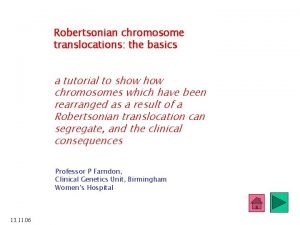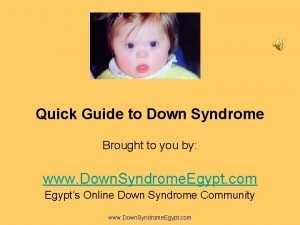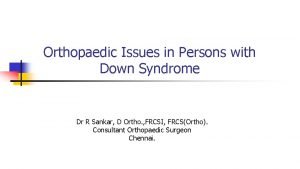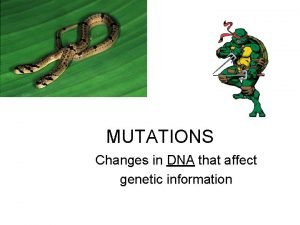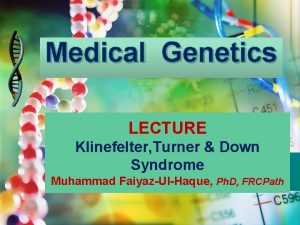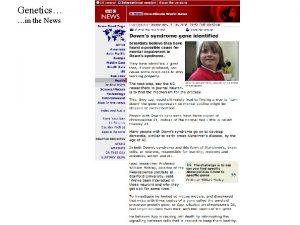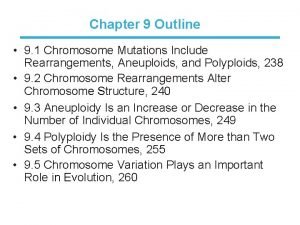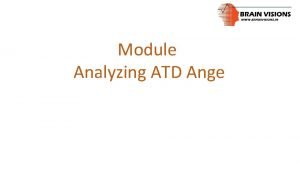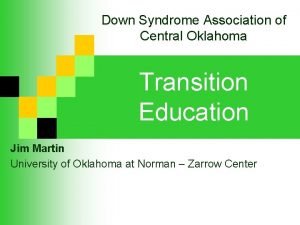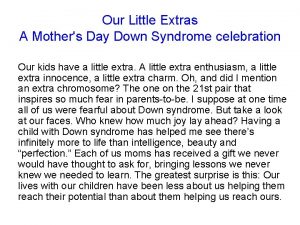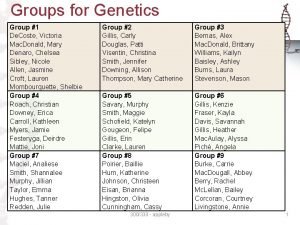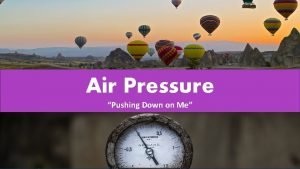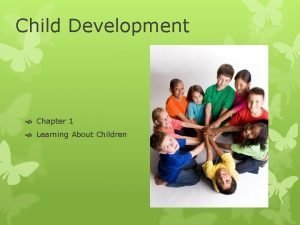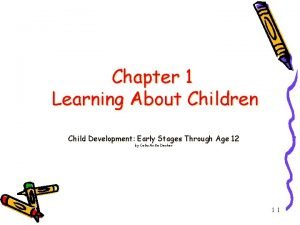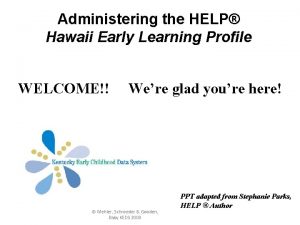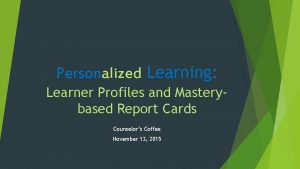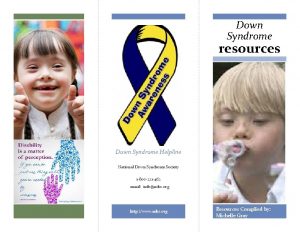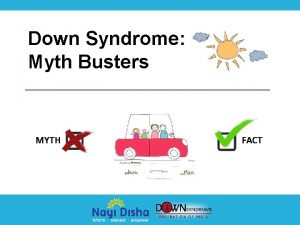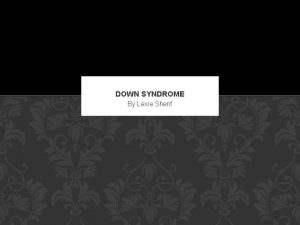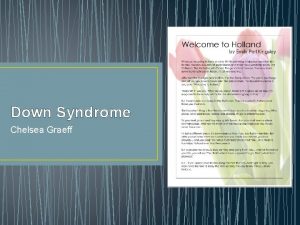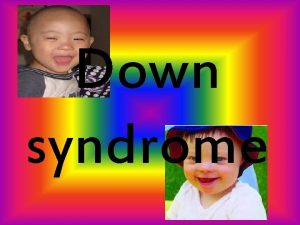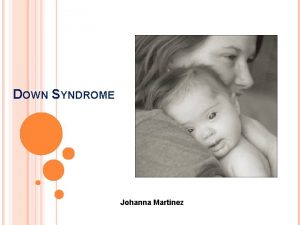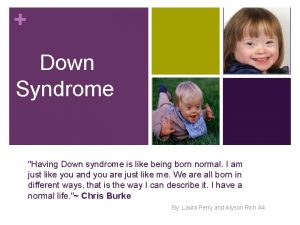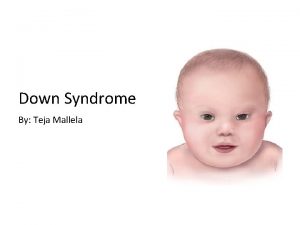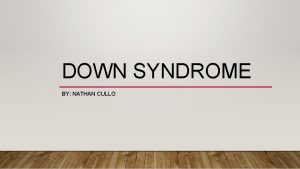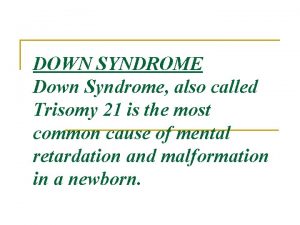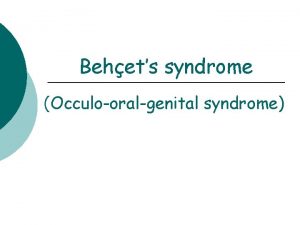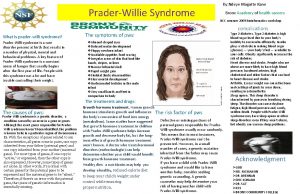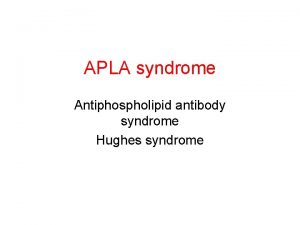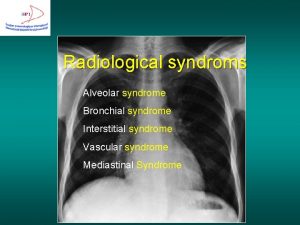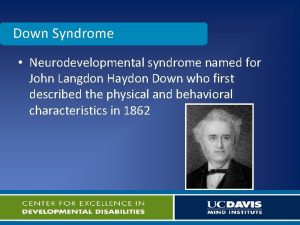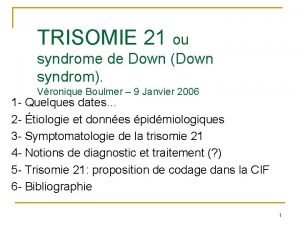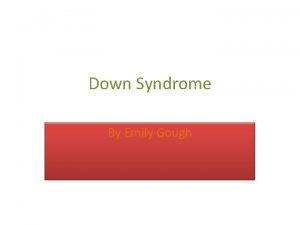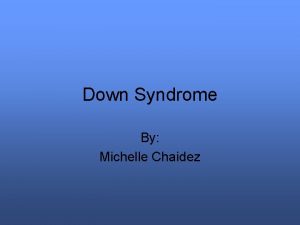Educating Children with Down Syndrome Learning Profile Effective














































- Slides: 46

Educating Children with Down Syndrome: Learning Profile Effective Teaching Practices Tools to Maximize Learning Success The Northern New England Down Syndrome Congress

Goals of Education �Same for children with Down syndrome as typically developing children �Develop skills and acquire knowledge for adult life leading to employment and career success; access to different forms of literature and technology �Learn the social values of culture �Reach Independence: Work, Social, Leisure �Ability to contribute to community and society �“The true purpose of education is to produce citizens. ” Archbishop of York

New Frontier! �In most countries, children with DS gained access to the curriculum only within the last 30 years. �Research is limited but growing, and continues to demonstrate that children with DS are able to develop the literacy and math skills needed for successful employment and independence. �Success occurs when they are taught with strategies that meet their specific learning profile.

Down Syndrome Learning Profile: Knowing which keys to use will open many doors!

What is Down Syndrome? � Trisomy 21 � This is the most common form of Down syndrome, accounting for about 95% of all cases. A person with Trisomy 21 has three copies of chromosome 21 (instead of the usual two copies) in every cell of his or her body. � Mosaic Down Syndrome � This form of Down syndrome results when a person has an extra copy of chromosome 21 in only a portion of their body's cells. It occurs during cell division in one of two ways. In the first scenario, the original fertilized cell has three copies of chromosome 21, but as it begins to divide, a copy of the cell manages to repair itself. That results in a mixture of mutated cells dividing alongside normal cells to create the baby. In the second scenario, the original cell is a healthy cell, but as it begins to divide, the mutation occurs. Again, this results in a mixture of mutated cells dividing alongside healthy cells to create the baby. Although people with Mosaic Down syndrome do have healthy cells, the end result is basically the same – Down syndrome. They don't have a physical or mental advantage or disadvantage compared to other babies with Down Syndrome. � Translocation Down Syndrome � This form of Down syndrome occurs when part of chromosome 21 becomes attached (translocated) to another chromosome during the formation of egg and sperm cells, or very early in fetal development. Affected people have two copies of chromosome 21, plus extra material from chromosome 21 attached to another chromosome http: //downtownds. com

We Love the T-Shirts…. but as you now know, we can’t ALL wear them! Genetics is a funny thing! Although 95% of people with Down Syndrome share the common thread of an extra chromosome 21, each 21 st chromosome is still unique to each individual! A single chromosome does not have the power to dictate ALL parts of who a person is.

Effects on Development �MOST children will have delayed development of some sort. �There is a wide range of individual differences from mild to severe levels of disability �Not all areas are equally delayed. There are strengths and weaknesses. �Severity of disability CAN NOT be predicted at birth or in the early years (common question parents are asked). Down Syndrome Education International

Guess the average IQ range �In the last several years, the average IQ of a person with Down syndrome has increased. In people with Down syndrome, 39. 4% are in the mild intellectual disability range of 50 -70, and 1% in the borderline intellectual function range of 70 -80 (average IQ in the general population is 70 -130). http: //www. globaldownsyndrome. org/about-down-syndrome/facts-about-down-syndrome/ �What could be different that has caused this shift?

Typical Profile *See Hodapp, Fidler, Buckley in DSRP 9 (3) on DSEI Website Social understanding, empathy & social skills Hearing & Vision Motor Skills Self Help and Daily Living Skills Speech & Language Verbal Short Term Memory Information Processing Visual Short Term Memory Learning from Listening is Difficult Visual Learning a Strength Number Reading Weaknesses Non-Verbal Mental Age Strengths

Developmental Profile �Significant Risk of Vision and Hearing Impairments �Specific speech and language delays relative to non-verbal mental abilities. �Cognitive: � Verbal Working Memory= a weakness � Visual Memory and processing= a STRENGTH! �Academic: � Mathematics= a general weakness (often 2 yrs or more behind) � Reading= a STRENGTH! Can be at GRADE LEVEL (approximately 10%) � Motor Skills: We see early walkers/late talkers, and later walkers/early talkers… Down Syndrome Education International

Why Speech and Language Development is KEY! �Language is the building block of cognitive and social development for all children �Vocabulary Size= more words to express your knowledge and to communicate with �Language is used for exhibiting self-control and planning �Language is used to help us deal with emotions �Language is used to build friendships and to communicate with one another �Language is used to help us remember, think through things, recall, and reason, hence anybody with a language delay will have a cognitive delay Down Syndrome Education International

Taking Talking for Granted �Talking is one of the most common methods of communicating with another person �Beginning stages= looking, smiling, pointing- nonverbal skills for commenting, requesting, answering �Then WORDS- what do they mean (vocabulary), and how are they used? �Then SENTENCES- GRAMMAR= the ability to communicate more complex thoughts/ideas �The ABOVE all require CLEAR SPEECH Down Syndrome Education International

Putting it All Together For MOST children with Down Syndrome, spoken language is delayed for mental age, but they show an uneven profile. There is not a global delay! �Communication-non-verbal, social-skills are a strength �Vocabulary is delayed yet grows steadily �Receptive (what is understood) is ahead of their expressive (what they can orally express) language! � Never underestimate what these children know! �Grammar- more difficult �Tend to be “telegraphic” talkers, using key content words Down Syndrome Education International

Why is Vocabulary SO Important? �Vocabulary size feeds grammar development! �A child needs 200 -250 words before grammar can start to develop �Receptive language (what is understood) is ahead of expressive language (what can be produced) 200 -250 words understood to begin to understand grammar � 200 -250 words in spoken words to begin to USE grammar! � �There will be many Kindergarten and elementary age students who do not have 250 words in spontaneous spoken language. �CHALLENGE ACCEPTED! Down Syndrome Education International

How did this profile develop? �Hearing loss plays a part. 80% of children with Down Syndrome have some type of hearing loss. �Auditory Processing may play a part �Slow vocabulary learning may delay grammar �Weaker verbal short term memory �We need more information about early speech discrimination abilities among children with Down Syndrome �The causes of speech motor issues are not clear cut �Not just a motor issue �Planning piece �Verbal short term memory plays a role as well Down Syndrome Education International

WORKING MEMORY �Working memory is the immediate memory system that supports all mental activity. �If your computer has little memory on it, you will not be able to open and manipulate multiple programs. You will be forced to shut down/close one program to open another one that is needed, making you lose access to that information. �The more working memory you have on your computer, the more programs you can run and manipulate.

WORKING MEMORY �The working memory system has several components �The Central Executive- holds and processes information �Supported by limited capacity stores � The visual spatial scratchpad- to hold visual information � The phonological loop- holds verbal information � These both hold information from the senses for about 2 seconds!!! �The episodic buffer- links to long-term memory �Working memory increases with age! Down Syndrome Education International

http: //www. oxfordschoolblogs. co. uk- referencing “AS Complete Companion”

Executive Functioning �Children with Down Syndrome exhibit executive functioning weaknesses due to a structural difference in the frontal lobe. This can result in executive functioning difficulties such as impulsivity and can mimic ADHD type behaviors. �Because the biological origin of the executive functioning difficulty is different in nature from ADHD, pharmaceutical intervention DOES NOT WORK. This is not to say that a child with Down Syndrome is immune from ADHD in addition to Down Syndrome. This is where a trained psychiatrist who is knowledgeable about Down Syndrome would be vital!

How does Working Memory play a role in everyday Learning? �Working memory is necessary for: �Listening to another speaker �Decoding an unfamiliar word while holding on to the meaning of the previously decoded word in mind �Writing while formulating the next part of the text �Mental arithmetic �Following multiple step directions Down Syndrome Education International

Verbal Short Term Memory and the Language Connection �The phonological component supports verbal short term memory. �Verbal memory is influenced by increases in speech perception and production rates, and by reading ability!!! Therefore it can increase! �The phonological loop influences the learning of vocabulary and syntax- and storage and processing of sentences Down Syndrome Education International

Phonological Loop �Studies by Chris Jarrold and team at Bristol University, UK have shown that the deficits cannot be explained by hearing loss or speech difficulties alone! �Phonological loop deficit- affects word learning and memory �Difficulty with learning the accurate phonological or sound pattern of words �Some evidence is supporting that training can improve working memory function including some computer programs, like Cog. Med (www. cogmed. com)! Down Syndrome Education International

Cognitive Profile �We know that for children with Down syndrome: �READING IS A STRENGTH �“Once you learn to read, you will be forever free. ” - Frederick Douglas

Most Common – with Exceptions �Reading strength starts as logographic (sight) �Visual Working Memory a Strength �Reading comprehension levels are often behind reading and spelling levels. �Comprehension depends on vocabulary knowledge, grammar, working memory skills, and life knowledge. �Phonics Skills develop steadily, but at a slower rate than sight word ability �Rhyming is often challenging for children with DS

Literacy Continued �Many children with Down syndrome become phonological readers and learn to decode, but may do so at a slower rate than sight word acquisition �Language knowledge key for comprehension building; text must be meaningful and within the child’s language base although reading will also help expand that base Keys to Success: �MEANINGFUL TO CHILD. . VISUALLY APPEALING. . . �REPETITION/REPETITION

Early Literacy Instruction �Appleton, Mac. Donald, and Buckley, compared the progress of 18 children with Down syndrome with 18 typically developing children, 2 -4 years old �Parents taught Sight Words �Large individual differences, but after 6 months, 17 words for children with DS and 15 for others �After 3 years, progress compared: same level for reading and reading comprehension

Reciprocity �Reciprocity among Reading Skills, Speech and Language Development, and Working Memory �Levels of achievement for reading higher than may be expected given multiple delays �Early reading improves grammar and increases utterances (number of words spoken at once) – most likely due to strength of visual working memory �Intelligibility often improves when reading because working memory is able to focus on planning and articulating

Evidence-Based: Reading Leads to Better Speech � A research study, recently published in the Journal of Child Language [1], has reported that children with Down syndrome can benefit from the use of written words to support oral vocabulary learning. � “The authors conclude that "this study has shown that children with Down syndrome are able to learn the phonological form of new words to the same level as typically developing children matched for reading, and that they benefit from orthography to the same degree as typically developing children. A practical application of this work is that children would benefit from being shown a flashcard of the written form of a word when learning its spoken form. This lends empirical support to current practice recommended for children with Down syndrome. . . “ � This page is licensed under a Creative Commons Attribution 2. 0 UK: England & Wales License. You are free to to copy, distribute and display the content of this page, provided that you credit the author (Down Syndrome Education International) and that you provide a link to this original version (http: //www. dseinternational. org/en-gb/news/2013/03/08/flashcards-teachspoken-vocabulary/). For any reuse or distribution, you must also make clear to others these licence terms. You can easily comply with these conditions by keeping this notice in place on all copies. Find out more about copyright and permissions.

What the Research Tells Us… � As educational opportunities have expanded, so have literacy gains. � Children educated in mainstream, inclusive environments have higher levels of literacy than those in less inclusive environments. � Children introduced to reading in early years show greatest achievement, but a recent study shows that teenagers and adults can learn to read – they do not plateau – when taught with quality instruction � All children will benefit from being read to and taught literacy, regardless of level of achievement

http: //openbooksopendoors. com/research/ � ANNOTATED BIBLIOGRAPHY: READING INSTRUCTION FOR STUDENTS WITH INTELLECTUAL DISABILITIES � Allor, J. H. , Mathes, P. G. , Roberts, J. K. , Cheatham, J. P, & Champlin, T. M. (2010). Comprehensive reading instruction for students with intellectual disabilities: Findings from the first three years of a longitudinal study. Psychology in the Schools, 47, 445 -466. � This longitudinal experimental study showed that students with intellectual disabilities can learn to read given consistent, explicit, and comprehensive reading instruction over an extended period of time. � Baylis, P. , & Snowling, M. (2012). Evaluation of a phonological reading programme for children with Down syndrome. Child Language Teaching & Therapy, 28(1), 39 -56. doi: 10. 1177/0265659011414277 � This article reported the results of a 10 -week literacy program for children with Down syndrome who used a whole-word method to read. At the start of the study, participants demonstrated no apparent decoding skills. The literacy intervention included phonological awareness training, phonics, and whole word reading. All children showed significant improvement in word reading skill, alphabet knowledge and decoding with the majority retaining the gains three months after the program ended. � Kathleen Whitbread, Ph. D. , and many more research publications, resources, blogs, specific to children with Down syndrome….

What the Research Tells Us… �Research suggests that parents of children with disabilities have lower literacy expectations and engage in fewer literacy related experiences than those of typically developing children �Teacher knowledge and expertise correlates with student reading achievement �Teacher expectations affect student outcomes - Kathleen Whitbread, Ph. D.

We Can Make A Difference �Teachers who are well trained and utilize effective instructional strategies can improve reading outcomes �Home environments that expose children to literacy also have a positive impact on reading success

Intervention & Education �Target SPEECH and LANGUAGE from infancy though school years. The work will pay off! �VISUAL LEARNERS �Use literacy/reading to teach talking as early as 2 years old: READ!!! �Auditory learning is a WEAKNESS! Always pair activities that require listening to learn with VISUALS (signs, pictures, schedules, reading, computer) �Allow students to SHOW their knowledge without relying heavily on their ability to SPEAK their knowledge (choosing, pointing, selecting). Down Syndrome Education International

What Can Parents & Teachers Do? ! �Build on STRENGTHS! �Social Emotional Strengths �Build on emotional responsiveness- encourage social communication, looking, smiling, gesturing � Building block to cognitive and language development! �Talk to and play with children! �Encourage AGE appropriate behavior- do NOT baby or spoil students. Expectations and boundaries must be clear with follow through.

COMPENSATE for Weaknesses �Good health care is essential �Speak clearly �Use signs �Limit background noise �Address working memory difficulties with sound and word discrimination games from infancy, improving spoken language development and playing memory games �Encourage Motor Development – both Gross Motor and Fine Motor Skills �Growing evidence that inclusion in mainstream schools results in great growth when compared to students who were placed in a substantially different special education setting…participate in community activities Down Syndrome Education International

Intervention & Education �Focus on building vocabulary from early on! This will lead to a better understanding and use of grammar. �Speech skills and non-verbal communication intervention is strongly encouraged to start at the FIRST YEAR. �Games to develop speech discrimination skills and encouragement to produce speech sounds �Joint attention and pointing build non-verbal communication �Signing is commonly used as a way to close the gap between comprehension and production: a child with DS my sign the alphabet before being able to verbalize the letters

Inclusion �“Inclusion is one of the means by which children of all abilities and learning styles can access and learn from the structure of a common curriculum shared with their peers. ” -Gillian Bird, Sandy Alton and Cecilie Mackinnon

The Importance of Inclusion � A 1999 research study conducted by Sue Buckley, Gillian Bird, Ben Sacks, and Tamsin Archer followed 46 teenagers with DS, 18 in Inclusive School and 28 in Special Schools in the U. K. ; placement based on where they lived and not ability, similar social and family backgrounds, and potential abilities. � Results showed that children in the inclusive environment had greater gains in speech and language, literacy, socialization, daily living skills, and behavior. � Expressive Language 2 years ahead of those in special schools, Reading and Writing also significantly ahead. � One area where children in separate schools showed greater gains was in the sub-section of interpersonal relationships, indicated that teenagers with Down Syndrome did not develop strong friendships in the inclusive settings, whereas teenagers in separate schools had more friends and boyfriends/girlfriends. This implies the importance of keeping children with Down Syndrome connected with other children with disabilities. http: //www. down-syndrome. org/updates/166/updates-166. pdf

Research Findings by Sue Buckley, Gillian Bird, Ben Sacks and Tamsin Archer: Down Syndrome Educational Trust: http: //www. down-syndrome. org/updates/166/updates-166. pdf �“Our findings suggest that it is not possible to provide optimal learning environments in special schools and classrooms, however hard the teachers work. It suggests that learning within a typically developing peer group may be essential for optimal progress for two main reasons”: �“The typical spoken language of the peer group because this provides a stimulating language learning environment. ” �“The classroom learning environment and curriculum – the pace of learning has been much greater for those in mainstream because they have been in all academic lessons with individual support for their learning. ”

Recommendations Written by Buckley, Bird, Sacks, and Archer as a Result of Research: � 1. That all children with Down syndrome should be educated within mainstream classrooms to ensure that they are able to develop their speech and language to the level that is optimal for each child. � 2. That all children with Down syndrome should be educated in mainstream classroom to learn alongside their peers and to access the academic curriculum adapted to their individual rate of progress. � 3. Research indicates that it is not possible to provide a maximally effective learning environment in a special education classroom. � http: //www. down-syndrome. org/updates/166/updates-166. pdf

Recommendations… � 4. “The social aspects of inclusion need to be addressed”. “There were no differences on the Play and Leisure (going to clubs, games, hobbies, leisure activities) or on the Coping skills (awareness of manners, social sensitivity and social rules) subscales. On the Interpersonal Relationships subscale, the teenagers educated in the special schools scored significantly higher, largely due to differences in scores for the oldest age groups. “ � 5. “Friendships with non-disabled peers need more support within school communities”.

SPECIAL SCHOOLS & CLASSROOMS �One size does not fit all. When considering a child for a special class or school, it is the team’s responsibility to make sure that all supports and services have been exhausted in the general education setting and that the child is not making progress. �The decision to have a child access a special class or school, should be based on that child’s individual needs, and not due to blanketed statements and assumptions. �Look for alternative ways for the child to access different aspects of what the community offers, or the school in the case of special class within the public school, to ensure benefit from being with typically developing peers either in or out of school. �If a teams sole decision to look at a special class or school is based solely on academic ability and self-esteem, remember that it is the school’s responsibility to encourage a supportive community of all learners, and that the need to modify curriculum is not a reason in itself to move to a more restrictive environment.

References and Research �http: //www. dseusa. org �www. down-syndrome. org �http: //store. dseusa. org/ �http: //www. down-syndrome. org/perspectives/316/ �www. dsfoc. org �http: //openbooksopendoors. com/ �www. ndss. org �www. mdsc. org

RESOURCES � Sign Language � www. Signingsavvy. com � www. signingtime. com � Apps � www. bridgingapps. org � http: //a 4 cwsn. com/ � Education research/ programs � http: //www. dseinternational. org/en-gb/ � http: //www. dseusa. org/en-us/ � http: //www. down-syndrome. org/ � http: //www. cogmed. com/ (working memory) � Parent Support � www. saturdayexplorersofnewhampshire. blogspot. com � https: //www. facebook. com/NNEDSC (Northern New England Down Syndrome Congress…. new website will be launched in the fall) � http: //www. childrenshospital. org/clinicalservices/Site 2845/mainpage. S 2845 P 0. html (WONDERFUL access to videos from renowned experts!) � http: //www. globaldownsyndrome. org/about-down-syndrome/resources/

Resources �Social Skills �Personalized Stories � www. sandboxlearning. com �Social Story Videos � www. modelmekids. com �Social Thinking- Michelle Garcia Winner � www. socialthinking. com �Carol Gray � www. thegraycenter. org

Behavior + Learning + Inclusion “Challenging behavior not only precludes individuals with Down syndrome from learning opportunities within their environment, but also prevents them from accessing more typical educational and community environments as they approach preschool and school age. When placement in a general education or community setting does occur, challenging behavior is likely to be the cause of removal from these settings. This is particularly unfortunate, as general education settings have been found to lead to more positive outcomes for children with Down syndrome (Buckley, Bird, Sacks & Archer, 2002; Cunningham, Glenn, Lorenz, Cuckle & Shepperdson, 1998). “ � “Therefore, those (parents and educators!) who are likely to encounter behavior that may be associated with later negative outcomes must be prepared to address such behavior so that children with Down syndrome benefit from learning opportunities and are less likely to be precluded from general education/community placements. ” � Positive Behavior Creates Opportunity! � Addressing challenging behaviour in children with Down syndrome: The use of applied behaviour analysis for assessment and intervention, by Kathleen Feeley and Emily Jones
 Educating the mind without educating the heart source
Educating the mind without educating the heart source Learning profile of a child with down syndrome
Learning profile of a child with down syndrome Effective support for children and families in essex
Effective support for children and families in essex Difference
Difference Promoting services and educating customers
Promoting services and educating customers Educating rita symbolism
Educating rita symbolism Educating for careers conference
Educating for careers conference Educating the next generation of leaders
Educating the next generation of leaders Educating for eternity
Educating for eternity Promoting services and educating customers
Promoting services and educating customers Educating rita context
Educating rita context Chester children's chorus down in the river
Chester children's chorus down in the river Cuadro comparativo e-learning m-learning b-learning
Cuadro comparativo e-learning m-learning b-learning Familial down syndrome
Familial down syndrome Risk of down syndrome by age
Risk of down syndrome by age Is down syndrome autosomal or sexlinked
Is down syndrome autosomal or sexlinked Robertsonian translocation
Robertsonian translocation Types of down syndrome
Types of down syndrome Down syndrome screening results
Down syndrome screening results Phenylketonuria pedigree chart
Phenylketonuria pedigree chart Down syndrome pedigree chart
Down syndrome pedigree chart Life expectancy for down syndrome
Life expectancy for down syndrome Xyy syndrome
Xyy syndrome Is down syndrome dominant or recessive
Is down syndrome dominant or recessive Turner syndrome in males
Turner syndrome in males Effects of duplication
Effects of duplication Familial down syndrome
Familial down syndrome Systolic ejection murmur left sternal border
Systolic ejection murmur left sternal border Tendon histology
Tendon histology Atd angle in dermatoglyphics
Atd angle in dermatoglyphics Down syndrome association of central oklahoma
Down syndrome association of central oklahoma Criciate
Criciate Mioklonik epilepsi
Mioklonik epilepsi Pictures of down syndrome babies in the womb
Pictures of down syndrome babies in the womb Down syndrome ears vs normal ears
Down syndrome ears vs normal ears Extras down syndrome
Extras down syndrome Wesley homeshare
Wesley homeshare The sound of heaven touching earth
The sound of heaven touching earth Stand up sit down hands up break down
Stand up sit down hands up break down Here i bow down here i bow down
Here i bow down here i bow down Pushing down on me pushing down on you
Pushing down on me pushing down on you I fled him
I fled him Kinds in development chap 1
Kinds in development chap 1 Chapter 1 early learning
Chapter 1 early learning Hawaii early learning profile powerpoint
Hawaii early learning profile powerpoint Personalized learning learner profile
Personalized learning learner profile A learning profile of the learner includes
A learning profile of the learner includes
